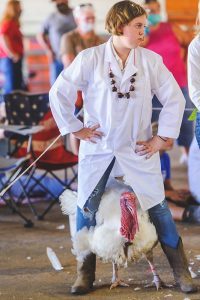4-H’ers show off large, healthy animals
MOUNT VERNON — Thanksgiving is coming early for some folks thanks to the 2020 Knox County Junior Fair Turkey Show; and with healthier birds, too.
Twenty-one turkeys were showcased at the fair this year, ranging in weight from 28.6 to 46.8 pounds.
The most important part of the turkey, in the eyes of the judges according to several 4-Hers, is the quality of the breast meat.
Case Armstrong, a Down on the Farm club 4-Her who has been taking animals to the fair for three years, said judges look for “how big the turkey breasts are and how big the drumsticks are.”
Mary Thomas, a New Horizons club 4-H’er, said that when you first start out with a baby turkey, you have to keep them warm and provide plenty of food and water. As they age, Thomas said she moves them outside to get some fresh air, all the while making sure that their food has enough protein in it. She feeds her turkey the food that can easily be bought from any local retail farm store. And once they’re big enough, it’s time to bring them to the fair.
“(Judges) look for a like a... like an equal amount of the breast. They don’t want one to be bigger than the other,” Thomas said. “And the drumsticks, (judges) want them to be even too, no bruises or cuts really.”
Thomas believes that the turkeys sold by 4-H’ers are just a bit better than the ones brought in the stores. The turkeys aren’t injected with anything and they’re not in really small compartments, she explained, which makes the meat just that much better.
And Redbrush club 4-Her Reagan Ward would agree that her turkey, and others at the fair, are much healthier.
“I would say definitely healthier, in my opinion because turkeys that are raised for meat are raised in barns. They don’t go outside, they have (little) room to move and there are thousands of them,” Ward said. “I would say (fair turkeys) have better quality meat just because of the conditions. They’re happy birds.”
And making a turkey happy is pretty simple. Ward explained that you just have to provide daily food and water, proper insulation in the building and a nice dry place for the turkey. Ward takes her bird outside every day to make sure they get fresh air and worms.
When it comes to comparing raising market animals to show animals, Thomas said market animals can be a bit difficult but at the same time easier.
“It’s a little harder making sure that it’s gaining enough weight and has a good diet,” Thomas said, adding that she has raised both market and breeding animals to bring to the fair for about 10 years. “But it’s a bit nicer making sure that you don’t have to worry about its feathers being pristine or anything. You just have to make sure the meat is good.”
Ward said that raising a market animal is a bit easier because with show animals, it’s more about the details.
“I would say breeding is more, it’s more about your knowledge of the animal,” Ward said. “If I took an egg layer, which is a breeding animal, then I would have to know about egg production.”
She added that there’s also a lot more grooming and washing knowledge that goes into show animals. Overall, there are just a lot more little details involved in show animals than market animals, where everything is pretty straightforward.


